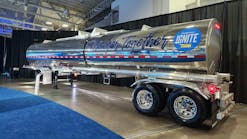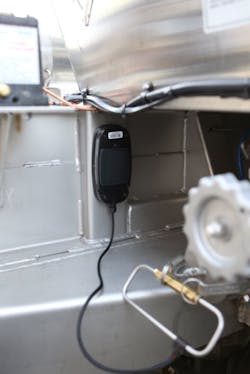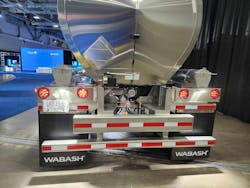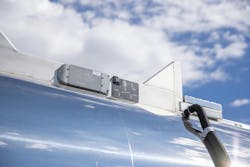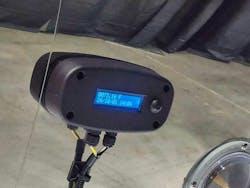Prototype tank trailer shows off seal monitoring, safety improvements
LOUISVILLE, Kentucky—Wabash displayed a new package of tank trailer technologies during its Wabash Ignite conference with developing features that emphasize safety and connectivity.
The prototype trailer boasted technology features both familiar and new, including seal sensors, extensive camera coverage, automatic lighting, light-out detection, and more.
“I think what separates Wabash’s tank trailer offering is the safety side of the features,” Adam Quinn, director of specialty sales at Wabash, told FleetOwner. “Fleets have been asking for some of these offerings ... and looked at different solutions, but not all as one package. We’re bringing all of this visibility in one package and then adding to it that safety side.”
Here are a few of the in-development tanker’s promising features:
Manlid seal visibility
One of the trailer’s standout tools allows for digital verification that a manlid is sealed. The trailer's Sure-Seal Sensors could help minimize how often employees need to scale tank trailers physically.
“Historically, and even common practice today, is that you have to go up and physically connect the seal and the driver has to check it,” Quinn said. “It’s just not a safe process. ... All that is very manual today.”
Reducing how often drivers have to climb the tank could be a big safety gain. In addition, it provides carriers an additional layer of assurance that the manlid is sealed throughout the trailer’s route. Sure-Seal Sensors could provide notifications of seal opening, seal closing, and cargo tampering events.
“That technology that we’ve developed is, once the shipper from a safe vantage point attaches the seal, there’s visibility that it’s connected; there’s visibility that it’s connected in transit; there’s history on it,” Quinn explained.
This manlid seal visibility feature would communicate its status through an online platform.
Smart workspace lighting
The tanker also featured a workspace lighting arrangement around the trailer that would activate automatically as personnel approach.
The Wabash 360 visibility feature uses a system of cameras around the cab to activate lighting around the cab automatically. This adds convenient visibility for anyone working around the trailer, such as during pretrip inspections.
“If a driver is going to go work in the workspace … the light will light up automatically, so it’s a safer workspace,” Quinn said.
Light-out detection
Digital warning of a nonfunctional trailer light was another helpful technology on the tanker.
“There’s a big concern with fines for having mandatory lights out,” Quinn told FleetOwner. “This will actually warn them that there’s a light out prior to leaving. In case it’s missed in the inspection or it happens while you’re driving, it will send a warning that a light has gone out on the vehicle.”
The feature could help to reduce unsafe operations and interactions with law enforcement.
Durable seals
Where tankers often use plastic strap seals, the display trailer showcased metal seals for increased durability.
“The idea is that it’s reusable and also is identifiable to the tank trailer itself,” Quinn explained. “Today, it’s manual. There’s a box of seals and you document the seal number to the trailer. Now, it’ll live with that trailer, essentially. It’s repeatable, this seal belongs in this trailer, and it’s tethered to it.”
All together on an open platform
All the technologies would be powered and coordinated by a Road Ready Master Control Unit from Clarience Technologies. The MCU's digital information would be compatible with a variety of other platforms.
“It’s going to be open platform, where it can connect to existing systems,” Quinn explained. “A lot of times the issue with other offerings is that it’s very confined in what you can connect.”
Other standout features of the tanker included temperature sensors, volumetric sensors, tire pressure monitoring, wheel-end event monitoring, and more.
“That, coupled together, gives a lot of power to the driver but also to central dispatch and wherever needed inside the company.”
After receiving feedback from fleets on the prototype at Wabash Ignite and Tank Truck Week, the company plans to have some of the technologies commercially available by the end of this year.
